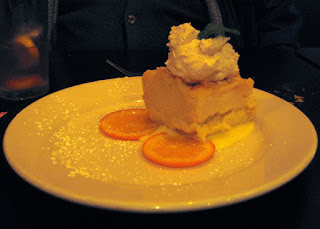ACME Blogging: The Camera Experiment
My two Most Faithful Readers and I went to ACME Food & Beverage Co. again, but this time we tried an experiment. Last time I ate at Blu, I left my SD memory card reader on my desk at home and borrowed my dad's camera. I noticed that the pictures taken with his camera were much brighter and sharper than most of the photos that I take with my camera. Note that my camera is a Canon Powershot SD500 with 7 megapixels and his is a Canon Powershot SD700 IS with 6 megapixels. My camera is two and a half years old and his is one year old. Pictures from both cameras have had Picasa's "I'm Feeling Lucky" filter applied. Yes, this experiment is about as scientific as you can get, because who knows what that filter does exactly? All photos were taken in manual mode, macro using ISO 200.
You may want to click on some of these to compare them closely. I think my mom's Field Greens salad looks particularly beautiful and sharp in the lower photo, taken with my dad's camera. All the images taken with my camera look kind of yellow.
This is a ginger bread pudding with candied orange pieces and cinnamon whipped cream. It was very nice. Again, I think it looks better with my dad's camera.
In conclusion, I would say that I did give my dad a very nice camera as a Christmas/retirement gift last year. It looks as if Canon has continued to improve their Elph camera even as prices have gone down. I also don't think I have the best compact camera for food blogging, but on the other hand, I did use my camera on my Treo for years, and it's a lot better than that.












People don't tend to think about the fact
ReplyDeletethat digital cameras are made of integrated circuits and thus subject to moore's law; they double in quality/power/fidelity/quintessence every year.
Oy. Even just the white-balance fix is worth the price of admission..
ReplyDeleteAlso: in relation to moore's law, sometimes it's kind of hurts digicams as well. For the processing, it's usually great, but there are too many cameras with too many pixels for their optics (or just too fine pixel pitch in general). It's one of those annoying "more may not be better" things that crops up when people blindly expand features..
You should set both cameras with a white balance suitable for indoor lighting, and try again.
ReplyDeleteI often prefer my indoor shots to look a little yellow; the alternative is often to live with distracting pink shadows.
White balance is almost definitely the issue here, especially if you're in "manual" mode.
ReplyDeleteThanks for the advice, everyone. It looks as if I had the white balance set on "cloudy" so I switched it to auto-white-balance, which I suspect is how my dad's camera has set. From focusing on a piece of paper in my dimly lit bedroom, I think that may have done the trick. At least it doesn't look yellow. The exposure also seems to be set to -1 and the manual recommends 0, so I might want to change that as well. Auto everything worked just fine until I started taking food pictures. ;)
ReplyDeletethe human eye/brain combo is a remarkable instrument for processing color, especially when it comes to picking the lightest/darkest things around and assigning them to "white" and "black" and removing color casts based on what are sometimes called "memory colors", yadda yadda yadda.
ReplyDeleteCCDs and microprocessors not so much.
you need to tell your camera what "white" is every once in a while, especially if you shoot under different lighting conditions. Fluorescent, CF, incandescent, tungsten and whatever else is used to create light generally does so at a different color temperature, and cameras just aren't smart enough to know that intuitively.
yet.
at least you don't have to change film every time your lighting conditions change any more.
If I have it set on AWB(auto white balance), then I don't think I need configure what white is, but I get into situations where I'm still not happy with what it's doing, I can set it to custom white balance and then I have to focus on something white, so I might want to start carrying around a sheet of paper with me. Restaurants, especially this time of year, are almost always dimly/warmly lit.
ReplyDelete